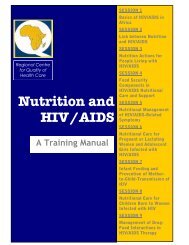2.1: Anthropometric Indicators Measurement Guide - Linkages Project
2.1: Anthropometric Indicators Measurement Guide - Linkages Project
2.1: Anthropometric Indicators Measurement Guide - Linkages Project
Create successful ePaper yourself
Turn your PDF publications into a flip-book with our unique Google optimized e-Paper software.
Figure A3.2. Values of Z alpha (Z∞) and Z beta (Zß)<br />
alpha ∞<br />
.90<br />
.95<br />
.975<br />
.99<br />
One-tailed test<br />
1.282<br />
1.645<br />
1.960<br />
2.326<br />
Two-tailed test<br />
1.645<br />
1.960<br />
2.240<br />
2.576<br />
beta ß<br />
.80<br />
.90<br />
.95<br />
.975<br />
.999<br />
Z beta Z ß<br />
0.840<br />
1.282<br />
1.645<br />
1.960<br />
2.320<br />
Figure A3.3. Illustrative sample size calculations for indicators expressed as proportions<br />
Example 1<br />
Suppose that it were desired to measure a decrease in the prevalence of underweight (weight-for-age) of 10<br />
percentage points. At the time of the first survey, it is thought that about 40 percent of children between 12<br />
and 36 months were underweight. Thus, P1 = .40 and P2 = .30. Using ‘standard’ parameters of 95 percent level<br />
of significance and 80 percent power, values from Figure A5.2 of alpha (∞) = 1.645 (for a one-tailed test - see<br />
below for further discussion) and beta (ß) = 0.840 are chosen. Inserting these values into the above formula,<br />
we obtain:<br />
n = 2 [(1.645 + 0.840) 2 * ((.3)(.7) + (.6)(.4))] / (.3 - .4) 2<br />
= 2 [(6.175 * 0.45)] / .01<br />
= 2 * [2.77875] / .01 = 2 (277.875) = 555.75<br />
or 556 households per survey round.<br />
Figure A3.4 provides a "lookup" table based upon the above formula to permit sample sizes to be chosen<br />
without having to perform calculations. The table provides sample sizes needed to measure changes/differences<br />
in a given indicator of specified magnitudes P two minus P one (P2 - P1) for different initial levels of the<br />
indicator (P1). The table is for values of alpha (∞) = 0.95 and beta (ß) = 0.80.<br />
Figure A3.4. Sample sizes required for selected combinations of P one (P1) and changes<br />
or comparison-group differences to be detected (for alpha (∞) = .95 and beta (ß) = .80)<br />
Change/difference to be detected (P2 - P1) (P two minus P one)<br />
P one<br />
P1<br />
.05<br />
.10<br />
.15<br />
.20<br />
.25<br />
.30<br />
.10<br />
.15<br />
.20<br />
.25<br />
.30<br />
.35<br />
.40<br />
.45<br />
.50<br />
1,075<br />
1,420<br />
1,176<br />
1,964<br />
2,161<br />
2,310<br />
2,408<br />
2,458<br />
2,458<br />
309<br />
389<br />
457<br />
513<br />
556<br />
587<br />
606<br />
611<br />
606<br />
152<br />
185<br />
213<br />
235<br />
251<br />
262<br />
268<br />
268<br />
262<br />
93<br />
110<br />
124<br />
134<br />
142<br />
147<br />
148<br />
147<br />
142<br />
63<br />
73<br />
81<br />
57<br />
90<br />
92<br />
92<br />
90<br />
87<br />
45<br />
52<br />
56<br />
60<br />
62<br />
62<br />
62<br />
60<br />
56<br />
9.<br />
Note: sample sizes shown assume a design effect of 2.0 and one-tailed tests. In a study of population-based cluster surveys to<br />
determine the design effects Katz (AJCN, 1995 Jan; 61(1):155-60) found the design effect range from 0.44 to 2.59. The use of<br />
D=2.0, therefore is conservative. For values of P one (P1) greater than .50, use the value in the table that differs from .50 by<br />
the same amount. For example, for P one (P1 ) = .60, use the value for P one (P1 ) = .40; for P one (P1 ) = .70, use the value for<br />
P one (P1 ) = .30.<br />
72

















